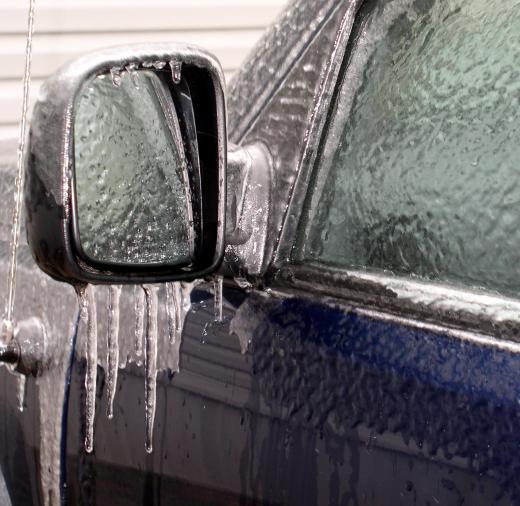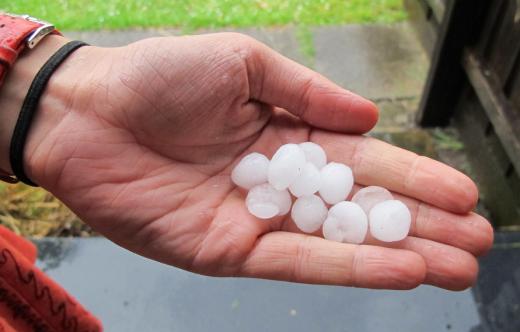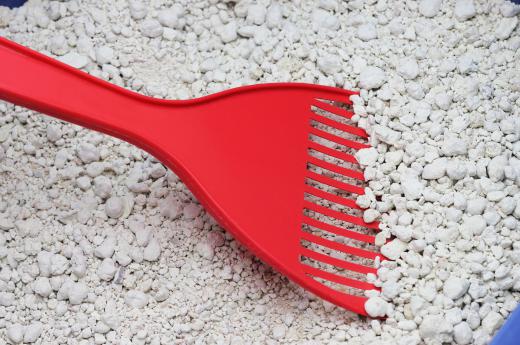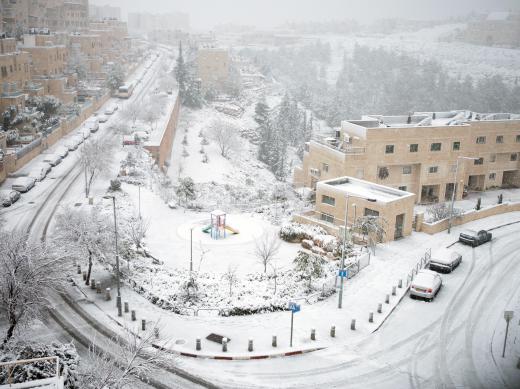What is Sleet?
Sleet is a form of wintry precipitation, but its exact definition depends on location. In some countries — for example, the United Kingdom, Canada and Australia — the term refers to snow that has partially melted on its way to the ground. In the United States, this is called slush or wet snow. To meteorologists in the USA, sleet consists of frozen raindrops that hit the surface as little ice pellets. These are quite distinct from hailstones, which form in a different way, and can occur at any time of year.
Types of Precipitation

The term precipitation refers to water in any form that falls from the sky. In wintry conditions, it may be frozen, or partly frozen. Snow consists of ice crystals that form by water vapor condensing directly into solid form, without first forming water. Hail is generally more common in summer, and forms in huge cumulonimbus clouds that often produce thunderstorms. Hailstones form by water droplets freezing onto ice crystals, often repeatedly, as strong, upward and downward winds, caused by convection, lift them up and down within the cloud.

In the USA, sleet and freezing rain often occur together, or in quick succession. Sleet consists of small pellets of ice that form by the freezing of raindrops or partially melted snowflakes as they fall through a layer of cold air. Freezing rain is made up of supercooled water droplets that freeze on contact with the ground, or other surfaces. In other countries, sleet means snow that has partly melted by falling through a layer of warmer air.
Formation

Both these phenomena are seen exclusively in the winter months, as a product of a winter storm system. They result from variations in air temperature at different altitudes. Sleet is an indicator of both cold and relatively warm air aloft in a winter storm system.
For example, in the USA, a weather system that dumps snow in the Midwest does so because the air temperature is below freezing, through all the layers of the system. This is not necessarily the case in the south, where winter temperatures are often a little above freezing point at the surface. There are alternate layers of warm and cold air, so any snow or rain that falls has a chance to melt, re-freeze and melt, possibly several times, on its way to the ground.

The south most often receives snow when a cold air mass precedes the precipitation by a day or two. When the cold air and the storm system arrive at about the same time, freezing rain and sleet are the usual result. Both tend to arise from snow melting or partially melting as it falls through a layer of warmer air, and then falling through a further layer of cold air near the ground. Freezing rain tends to occur when the warm layer is quite thick, and the lower, cold layer is relatively thin, giving the snow time to melt completely, and stay liquid until it hits the ground and freezes again. Sleet happens when the warm layer is thinner, and the cold layer thicker, so that the falling snow does not melt completely, then freezes again as it falls through the cold layer before reaching the ground.
Hazards
Sleet, in the sense of wet snow, is unpleasant as it is wet, like rain, and also very cold, but does not usually pose a substantial hazard. The ice pellet form, as defined in the USA, is not especially hazardous in itself, but it is often associated with freezing rain. In climates where snow is not common, such as the Southeastern United States, a lot of frozen precipitation, in any form, is bad news. People can drive through snow, but not on ice. Sleet is nearly always accompanied by freezing rain in these kinds of weather systems and sticks to pavements and road surfaces as an icy glaze.
Freezing rain and sleet are also the two components of the "ice storm." Snow may slow things down, but ice is destructive. It coats tree limbs and power lines, making them sag and break, due to the weight. Ice causes widespread power outages and structural damage from falling tree limbs. The best way to deal with these conditions is to stay inside if possible. Ice is treacherous and can easily cause falls or other accidents. It is also advisable to have some emergency supplies available in case the power goes out.
AS FEATURED ON:
AS FEATURED ON:














Discussion Comments
@sunshined – It's awful when sleet and freezing rain break power lines. Back in the nineties, my area saw an ice storm like this, and we were without power for two weeks!
The limbs on the trees got very heavy. I would go outside to break some of the ice off and put it in a cooler so that I could put some of the stuff that had been in the refrigerator in it and keep it from spoiling. The one good thing about this was that there was plenty of ice!
The downed power lines were a big challenge for the electric company. Some areas got their power back in a few days, but the rest of us had to wait.
I didn't see much traffic on my road during this time. The only trucks I saw were crews coming out to get rid of the tree branches across the road.
@StarJo – I agree with you. I'm terrified of hail!
However, if we are talking sleet vs. snow, I would choose snow every time. You can't go out and play in pure sleet, but if you have snow and ice together, you can make snowmen and go sledding.
I know several school kids who would choose sleet, though. School won't be canceled for a light snow, but if there is sleet on the roads, it certainly will.
I still think I would prefer sleet to a hailstorm. Most people would choose sleet in the question of sleet vs. hail, but I know too much about hail.
I live in tornado alley, and whenever we get large hail, it means there is rotation somewhere in the sky. The funnel could drop at any point.
Also, hail can get very large. I've seen golf ball sized hail, and I've seen photos of grapefruit sized hail! When something that big hits your car or house, there is going to be damage.
Sleet is so little. It isn't even the size of a pea!
In Mississippi where I live, the weather is completely bonkers during the winter. Just last week, we went from two days of seventy degree temperatures to being in the thirties and having sleet and freezing rain.
A thunderstorm came through while it was hot and dropped the temperature dramatically. We went down thirty degrees in one day!
Then, the sleet came. It started out as ice balls, but then, rain got mixed in with it. This is when trees and cars got coated.
I have lived in the Southeast my whole life so seldom see snow. When we have any snow, it only lasts for a short time and the kids are pretty excited about it. The worst part is driving around in it as nobody is used to it.
We have freezing rain or sleet more often than we get snow. Even though I don't like this, the temperature usually warms back up pretty quickly so it doesn't last very long. I don't think I would like living in a climate where the ice would stick around for a few months until spring.
We live in the country and if they are predicting any kind of sleet or freezing rain in the forecast, I try to get to the store and get all the food and supplies I may need for a few days. I am not the only one thinking this way as the store is either packed with people, or many essential items are cleared off the shelves.
There have been times after a heavy sleet that we are without electricity for a few days. The ice covers all the power lines and you aren't surprised when the electricity goes off. This isn't so bad if it is just for a few hours, but when it goes longer than that, it can really be a pain.
It also covers all the trees and cleaning up after a sleet storm is a big mess. Everything from big branches to small limbs break and fall off the trees.
It only has to be a temperature difference of a few degrees to determine whether you are going to have sleet, rain or snow. Whenever the temperature is hovering right around the freezing point, I know it can easily go either way.
I live in the Midwest so we get more than our share of both sleet and snow, and I agree that if given a choice, I would prefer snow. When I am sitting inside and can hear the ice pellets hitting the windows I know what is happening outside.
I don't have a garage to park my car in, and know that my car is going to take a long time to thaw out after we have a sleet storm. Years ago before you could automatically unlock your car, I remember using hot water to melt the ice just to be able to get my key in the lock.
@anon54429-- The best way I would describe the difference between sleet and snow is that even though snow is frozen precipitation, it does not leave a coating of ice like sleet does.
Whenever I hear that we are going to have freezing rain or sleet in the forecast, I always worry about driving. I can handle driving and walking around in snow, but ice is a much different story.
It is much harder to keep control of your vehicle if you are driving on ice. It is best to just stay home and wait until the roads are clear if you have that option.
Wow, someone else from Georgia here. How interesting.
presently we were discussing about artificial rain making. could someone out there can explain how this happen?
It is good that the difference between sleet and hail was mentioned (although the difference feels somewhat 'artificial'). Essentially the two seem the same to me, as both are frozen rain.
The European meaning of sleet though, is different from hail. I suppose that at some point the original meaning of sleet was changed in the US to meaning the same as hail (for the people on the ground anyway. I guess there are not too many people out there that can tell what kind of cloud the hail/sleet came from).
I had to visit this website for a science lesson and this made it very easy to comprehend. Thanks a bunch wiseGEEK!
Great article--easy to understand. Thank you!
this kind of helped me but i'm wanting to know the differences between sleet and snow -- the alikes and differences.
Freezing rain is snow that has melted, then freezes upon contact with the ground. This definition is the same all over the world. --Atmospheric Science Student
Is this how the American definition of sleet occurs? if so, can you explain the how the European/UK definition occurs?
Thank you for the info. helped me with my science project due tomorrow! i hope you can help me with the last 3 research topics like you did with hail, and sleet. hopefully you have relative humidity, humidity, and dew point!
Thanks, Anonymous
It would be rain. It is too warm for winter precipitation.
Would precipitation in southwest Georgia be sleet
or just rain if temp is 43 degrees F?
Post your comments